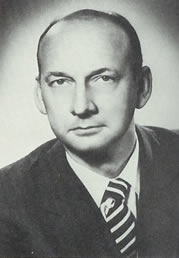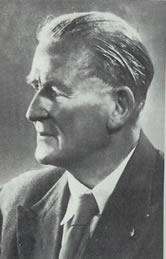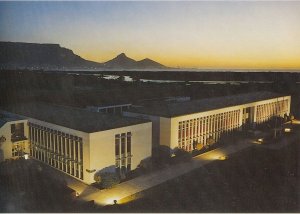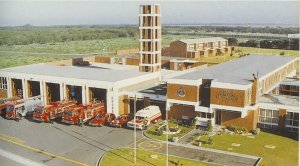|
||
|
Chapter 20 - Municipal Advance One pioneer who passed away on April 19, 1956, was the former Chairman of Milnerton Estates, F. H. Sargeant. "He was a kindly man," said Sir De Villiers Graaff, "beloved for his considerateness and friendliness to all with whom he came in contact. His principles were of the highest and he had set a fine example of business integrity to all his associates. His keen and discerning intellect, though trained in other spheres, revealed great business ability and acumen. It was his genius that he could not only grasp the big issues but gave the most meticulous attention to detail. Even when his health had broken down," he added, "he never relaxed his efforts in the interests of the Company." Now that he was gone he was succeeded by another veteran of the firm, C. A. Raats, who had worked himself up from office boy to the position of Chairman.
After a highly-successful period of office, during which both he and his wife devoted much time to the welfare of the community, A. H. L. Burmeister in November 1956 handed over his duties as Mayor to his deputy, G. H. Titterton. One of the first duties of the new incumbent was to arrange a Carol-singing function, "to serve the dual purpose of bringing together particularly the children of Milnerton in a Christmas celebration, and of raising funds for the Red Cross Hungarian Relief Appeal by means of a silver collection". This appeal was the outcome of the tragic ending to the revolt in Budapest, which had recently been beaten down by Soviet troops. Against a more homely background was a braai, held with the approval and assistance of His Worship, for the staff of the Fire Brigade on February 14, 1958.
Indicative of the usually peaceful condition of the streets was a complaint received about damage done to gardens at night by unattended horses, most of them strays from the racing stables. To remedy this, the novel step was taken of awarding a bonus of 5/- per head to any labourer who succeeded in impounding any of these animals. One satisfactory step taken at this time and brought to speedy fruition was the setting up of Milnerton High School. Here the first tenders were called in 1958, the building itself being completed and formally opened by Mr. D. J. Liebenberg, Cape Director of Education, on October 24, 1960. By far the biggest pending project for the Municipality was the provision of Sewerage, estimated to cost the then gigantic sum of £250 000. Delays were mainly due to the Housing Schemes, fathered by the Divisional Council and already discussed with the old Local Board. With Milnerton Municipality now legally in a position to administer its own scheme, work began in 1957, while in 1958 it was possible to complete the needful arrangements for the outfall on the farm Potsdam. Within another 12 months this highly-important amenity was in operation, the expenditure having reached £290 000. June 1956 was a milestone in the transportation history of Milnerton, for it brought the end of the old Railway service. Latterly it had been restricted to conveying race horses and now even this was stopped. "This means," the Company was informed by the S.A.R., "that all traffic on the Company's line, from beyond Paarden Island Township, is suspended indefinitely." Moreover the Department declined to make use of its statutory powers to purchase the installation. Instead the management of the Milnerton Estates learnt that the section of the line was to be abandoned. One immediate problem was the future use for the 60-foot strip running through the township. North of Zastron Road, so it was felt, it could "probably be integrated with the adjoining land. . ." but southward the situation was complicated by public roads. Fortunately however the strip was found useful in providing for wider highways, some of them used by the extended bus service installed by the Cape Town Tramways Company in 1958. Another piece of derelict land, triangular in shape, and East of the Koeberg Road came into the news about the same time in consequence of the abandonment by the Post Office of the Beam Radio Station at Klipheuwel. The Department however retained ownership and ultimately converted it to other uses, as the terminal of its overseas cable. Important from the view of administrative efficiency was a step taken in 1957, when the first full-time Town Treasurer, M. V. Whitwam, was appointed, with an adequate staff followed in 1965 by Harold Hulley. All things considered, the affairs of the young Milnerton Municipality were running smoothly and time was even found in February 1959 to acquire a Municipal Coat-of-Arms, the design of which was placed in the hands of Frank Waller, well known as a heraldic artist in Cape Town. Later in the same year steps were taken to have the emblem formally registered, in time for the forthcoming 50th Jubilee Celebrations of the Union of South Africa. So steady was the growth in administrative activities that hired accommodation was no longer adequate and several Councillors in November 1959 put proposals, "that serious consideration be given to buying a suitable property and converting it for use as an office". It was therefore to the dismay of local patriots that Dr. A. C. Levenstein, another of the Councillors, raised the question of incorporating Milnerton into Cape Town. Though he was ruled out of order, the subject was revived several times in ensuing months, amongst others by Major A. Z. Berman, who, as a member of the Cape Town City Council, launched an open attack on Milnerton and its activities. "There is a strong movement afoot at Milnerton," he told his colleagues at a meeting on April 27, 1959, "to join Cape Town. They are already paying higher rates than Cape Town and they are broke to the wide world."
Considerable annoyance was felt at these sentiments and the Milnerton Council publicly expressed its regret at his action in using "such slang expressions as 'Broke to the wide world', which suggested insolvency to those not aware of the full facts. Close study of the Major's explanatory letter elicits the fact that he intends merely to convey contempt for a newly fledged local authority, which has not the resources that a city of long standing, like Cape Town, has or should have". Further rebuttals of Berman's accusations followed, and a warning issued against "Milnerton ratepayers being stampeded by the Major's distortion of the facts into seeking incorporation into Cape Town". The protest ended: "This Council records that Milnerton is well able to pay for all necessary amenities and that the overwhelming majority of its ratepayers have come here, not to enjoy low rates, but to find the peace which is absent in the ill-planned and commercialised Mother City, and expresses its hope and that of the citizens that our town will be spared further vindictive and malicious remarks from Major Berman". "Such statements," added Dr. G. Futeran, the Acting Mayor, "have done harm to public interest in Milnerton and are bound to affect market values of properties in this town." He warned that it might be necessary to take legal action. Happily, having had his say, the Mayor took up a more moderate attitude. While still expressing regret that Major Berman's accusations had been published at all, and that the press, more particularly the "Cape Argus" and "Die Burger", had given so much prominence to the affair, he added that he had received the assurance of the News Editor of "Die Burger" of his willingness to get all the facts from the Municipality and print them. "My object," said His Worship, "in referring to these press reports is to focus attention on this position, which has obtained in Milnerton for some time. I would particularly appeal to the Councillors to deal with the matter in a calm and dispassionate way. . . The function of a Municipal Council is to administer the town under its control in a businesslike manner and to the advantage of the community as a whole. We can only act in terms of the powers given to us by law, and these laws contain very explicit and very stringent provisions to ensure that we do this. . . A town cannot be administered by a number of different bodies working at variance with each other. The proper function of a Ratepayers' Association as I see it, is to ensure, first of all, that the most suitable Councillors are elected to run the town, and secondly, to act as a medium through which individual ratepayers can put forward suggestions. . . The Council is at all times willing to consider the views of Ratepayers, as expressed through their Association and to cooperate as fully as possible." The uproar now subsided and normal activities occupied the attention of the Council. Hints of things to come in days still a long way ahead were given in April 1960, when Councillor Mrs. Taylor enquired whether anything further had transpired in regard to plans for the erection of a Shopping Centre on the property known as Reidhof. As it happened the matter was still classed as confidential, and a later generation was to enjoy this amenity.
In keeping with the practice of most other Cape Municipalities, Milnerton now also started contributing towards the famous Nelspoort Tuberculosis Sanatorium, in the Karoo, while improved relations with the Mother City were implied in the discussions for participation in the conference, on February 29, 1960, to settle details for Milnerton's use of the new Cape Town Abattoir, about to be constructed. While refusing to bind itself indefinitely, Milnerton undertook, for the next 25 years, not to set up any slaughter facilities of its own. The first local news-sheet dates from 1960, when "The Milnerton Bulletin," made its debut, an attractively printed 8-page account of local affairs, in both official languages published by the Milnerton Ratepayers' Association. Higher standards in road-building were now adopted, commencing with the signing of a contract for bitumenising certain thoroughfares, while, to finance future capital works, an inaugural loan of £20 000, for 30 years at six per cent, was arranged with a Johannesburg house. Changes of universal importance provided a theme for a gathering on June 3, 1960, at the Parow Civic Centre, and under the Chairmanship of Mr. F. G. Tindale of the Cape Provincial Administration, on Decimalisation of Currency. Today, when pounds, shillings and pence are only a memory, it is worth noting that complaints were received that it would be "impossible to work to the fifth and seventh decimal point of a cent", and that losses would therefore be incurred by conversion, which will have to be met from a special fund. "Furthermore, in the change over, it is not impossible, that, owing to the pressure of work, officials will, on occasion, make mistakes which will lead to losses. It will be unfair under the circumstances to expect these officials to make good such losses. The Provincial Audit Office has agreed that such a fund would be justified and would be accepted in the audit." Like every other local authority, Milnerton Municipality entered vigorously into the celebrations of the Union Festival, which ran from May 22, 1960 till June 4, 1960, marking the first half-century of South Africa as a united country. It began with an interdenominational church service in the Milnerton Hall, conducted by Dominee H. A. Heyns, of the Dutch Reformed Church, being attended, not only by the Municipal Council but by the Milnerton Boy Scouts and Girl Guides, Cubs and Voortrekkers. Two days later, on Tuesday 24, a ceremony took place in Acacia Drive, now rechristened Union Avenue, while the new name of Unitas Park, the result of a competition, was formally bestowed by Mayor. On this occasion two old inhabitants of Milnerton and a pupil from each of the local schools planted a memorial tree, and festival badges were presented to scholars and elderly people. An Inter-Schools Sports Meeting' also took place on May 25 while the crescendo was the Union Day Handicap on May 31, 1960 at Ascot Racecourse, where the Milnerton Turf Club had organised a special programme with a Gold Plate as first prize. Still on the subject of parks, Milnerton, in January 1961, became a member of the National Botanic Society of South Africa with its headquarters at Kirstenbosch. As Dr. G. Futeran pointed out, at the modest cost of £35 per annum "the Council can, amongst others, obtain free seeds as well as valuable advice in the development of its own Parks and Gardens and possibly a Nursery". The following year permission was also given to G. Potgieter, a local resident, to start the systematic ringing of birds for scientific purposes, in order to trace the course of their migrations. Nor was the Council unaware of the details that add to the status and dignity of its Municipality. Two portraits of early Mayors, W. J. Savage and P. Vlok, were purchased in 1961, while, almost immediately after, a \u0163\'a321 quotation was accepted for "cleaning, polishing, upholstering covering the Mayoral Chair". Even more substantial was the amount disbursed in 1964, when the Council unanimously agreed to spend R340, plus the cost of a Presentations Box for a Mayoral Chain done in solid silver, besides another R120 for a similar one, in the same material, for the Deputy Mayor. A coat-of-arms was also ordered in full colour, mounted on wood, 18 inches in height, at the cost of R42.50. For the first time too in 1960 Milnerton acted as Host to the Regional Meeting of Town Clerks in the Western Cape, an action repeated on August 24, 1962. With the whole subject of Municipal office accommodation steadily becoming more urgent, a lengthy investigation was carried out in 1963 by the Town Clerk on the question of putting up a Municipally-owned building. As a result he recommended that such a structure should be provided without delay, though he warned that the time was not yet ripe for what already many citizens were suggesting - a Civic Centre. The immediate needs were for the Town Clerk's Department, the Municipal Treasury, a "Council Chamber of ample proportions", room for the Town Planner and his staff, records, typists and other personnel. The only department, Mr. Koen considered, that could be separate, was that of Engineering and Works, which ought to be nearer the scene of their actual operations. Search now began for a suitable site, by a Committee set up under the Mayor, Councillor J. Gelb. Early in 1964 they recommended "the whole of the present playing fields area. . . excluding that portion required for addition to the High School, be set aside for Civic Centre purposes". An architect was appointed to work out a programme and so it came to pass.
|
||
|
|
||






